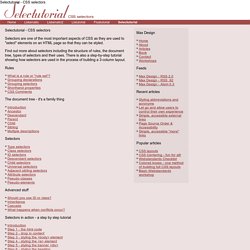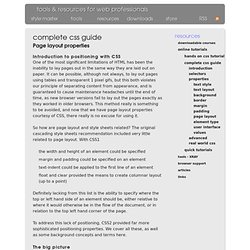

Selectutorial: CSS selectors. Selectutorial - CSS selectors Selectutorial - CSS selectors Selectors are one of the most important aspects of CSS as they are used to "select" elements on an HTML page so that they can be styled.

Find out more about selectors including the structure of rules, the document tree, types of selectors and their uses. There is also a step-by-step tutorial showing how selectors are used in the process of building a 3-column layout. Rules The document tree - it's a family thing Selectors Advanced stuff Selectors in action - a step by step tutorial Max Design Feeds Recent articles Popular articles. CSS Rounded Corners 'Roundup' 4Google + Note: This post is continually updated as I come across new techniques.

This collection of techniques to create boxes with rounded corners using CSS has become quite popular. The problem now is there are so many choices it's hard to know which one to choose. To that end I've provided some more information about each method in order to help people choose which best fits their needs. Some of these techniques use CSS and one or more background images, some use CSS, JavaScript and no images, and a couple use only CSS — no images or JavaScript required (more markup is needed though).
Not Sure Which One to Use? There are so many different techniques now, it really depends on your individual requirements and preferences; particularly whether you want to use a JavaScript-based technique or not. Try out a few methods and see if there's one that fits. Click on a column heading to sort the table by that column. Web Designer Wall - Design Trends and Tutorials. CSS-Tricks - Tips, Tricks, and Techniques on using Cascading Style Sheets. All CSS Properties Listed Alphabetically.
53 CSS-Techniques You Couldn’t Live Without. CSS is important.

And it is being used more and more often. Cascading Style Sheets offer many advantages you don’t have in table-layouts - and first of all a strict separation between layout, or design of the page, and the information, presented on the page. Thus the design of pages can be easily changed, just replacing a css-file with another one. Isn’t it great? Well, actualy, it is. CSS is important. Over the last few years web-developers have written many articles about CSS and developed many useful techniques, which can save you a lot of time - of course, if you are able to find them in time. Let’s take a look at 53 CSS-based techniques here at Smashing Mag you should always have ready to hand if you develop web-sites. 1. 2. 3. 4. 5 Powerful Tips And Tricks For Print Style Sheets 5.
Generated content was first introduced in the CSS2 specification. 7. 8. 9. 10. Stephen Shaw introduces a technique for perfect horizontal and vertical centering in CSS, at any width or height. Top 10 CSS Tutorials - Cameron Olthuis. Learn CSS Positioning in Ten Steps: position static relative absolute float. 1. position:static The default positioning for all elements is position:static, which means the element is not positioned and occurs where it normally would in the document.

Normally you wouldn't specify this unless you needed to override a positioning that had been previously set. 2. position:relative If you specify position:relative, then you can use top or bottom, and left or right to move the element relative to where it would normally occur in the document. Let's move div-1 down 20 pixels, and to the left 40 pixels: Notice the space where div-1 normally would have been if we had not moved it: now it is an empty space. It appears that position:relative is not very useful, but it will perform an important task later in this tutorial. 3. position:absolute When you specify position:absolute, the element is removed from the document and placed exactly where you tell it to go. Let's move div-1a to the top right of the page:
The Complete CSS tutorial. Css guide - page layout properties. Introduction to positioning with CSS One of the most significant limitations of HTML has been the inability to lay pages out in the same way they are laid out on paper.

It can be possible, although not always, to lay out pages using tables and transparent 1 pixel gifs, but this both violates our principle of separating content from appearance, and is guaranteed to cause maintenance headaches until the end of time, as new browser versions fail to lay out the pages exactly as they worked in older browsers. This method really is something to be avoided, and now that we have page layout properties courtesy of CSS, there really is no excuse for using it.
So how are page layout and style sheets related? The original cascading style sheets recommendation included very little related to page layout. To address this lack of positioning, CSS2 provided far more sophisticated positioning properties. The big picture So what is missing from HTML when it comes to page layout? A note about "layers" top. Complete CSS Guide - Cascading style sheets reference - Contents.